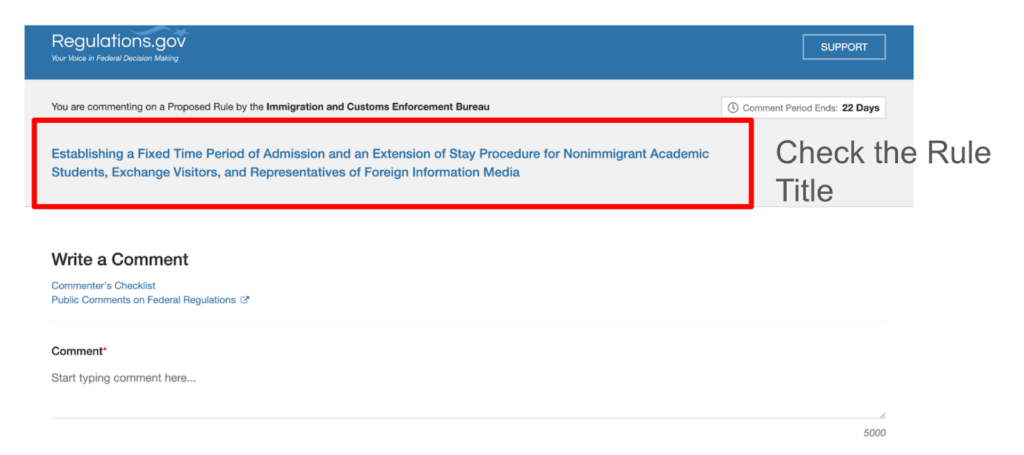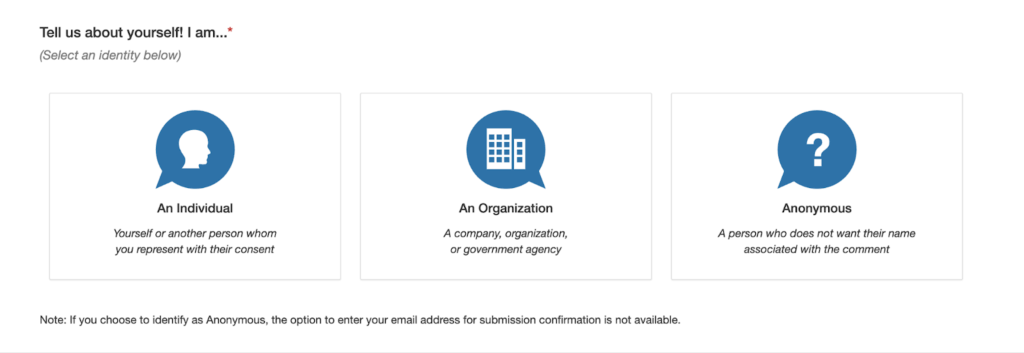2025年8月28日(星期四),美国国土安全部(DHS)在《联邦公报》上发布了一项拟议规则,旨在终止 F 类和 J 类非移民的“身份有效期”(D/S)制度。请注意,该规则目前尚为“拟议”阶段——在公众发表评论、DHS 审核意见、可能进行修订、并最终发布生效规则之前,该规则不会生效。本文将介绍这项新规包含的内容,以及如何撰写和提交政策评论。请大家行动起来,将本文转发给身边的朋友,并在9月29日 11:59pm(美国东部时间)之前按照本文指南撰写并在美国政府网站提交自己的评论!
“身份有效期”是什么?
过去 30 多年来,包括 F-1 学生、F-2 陪读、J-1 学生与学者、J-2 陪读在内的某些非移民身份,被授予的是“身份有效期”(D/S),而不是一个具体的到期日。持 D/S 身份的个人,其 I-94 入境记录上的“admit until date”(允许停留至)一栏会显示 “D/S”。这意味着,只要其 I-20 或 DS-2019 有效,并且正在进行的学习或研究活动尚未完成,就可以合法留在美国(当然需符合延期资格和某些规则)。
拟议变动内容包括:
- 新提案不再允许“身份有效期”(D/S)制度。F 类与 J 类非移民的入境许可将只持续至其 I-20 或 DS-2019 上注明的项目结束日期(最长不超过 4 年),以及项目结束后的 30 天停留期。
- 若需继续停留(如完成项目、转学、升学,或进行毕业后的实习/培训,如 F-1 OPT、STEM OPT 或 J-1 Academic Training),必须在允许停留期结束前及时向 USCIS 提交延期停留申请(EOS)。
- 延期申请通常须提交表格 I-539(申请延期/变更非移民身份)。若不提交,可能导致未经授权的停留。而这伴随着高昂的费用(约 500 美元,若选择加急处理则为 1,750 美元)和冗长的处理时间(通常为 3–9 个月)。每次延长期限仅为一年,这意味着国际学生在最初的四年期满后必须每年重新申请,直到完成学业;但如果延期申请被拒,学生在美国的合法身份将立即终止。
- 同时还提出若干相关修改,包括:
- 将 F 类当前 60 天的宽限期 (grace period) 缩减至 30 天(目前 J 类是 30 天)。
- F-1 本科生在第一学年内不得更换项目、专业或学历层级;研究生及以上层级的 F-1 学生在整个学习期间不得更换项目。
- 若在某一层级完成项目,F-1 学生无法再次以同一级或更低级项目身份入学。
- 除非获得 SEVP 授权,F-1 学生在获取首次 I-20 学校的一个学年学业完成之前,不得转校。
- 如果 F 或 J 身份的人在延期(EOS)申请还在等待审理期间出境并返回美国,通常可以被允许按原停留期限的剩余时间入境,这样 EOS 申请不会算作放弃。但如果在入境时出示的材料让海关与边境保护局(CBP)官员直接批准了延长期限入境,那么原来的 EOS 申请就会被视为放弃。
- 针对在规则生效日期前已持 D/S 身份入境的个人,拟设复杂的过渡条款。
- 若未及时提交延期申请或离境,将从其规定停留期结束之日开始计入非法滞留。按照现行政策,持 D/S 身份的非移民只有在 USCIS 正式发现身份违规或移民法庭下达排除、驱逐、移除等裁定后,才被认定开始非法滞留。
下一步是什么?
- 目前该规则仍为“拟议”阶段,任何个人或组织均有机会在规定期限内提交公众意见。高等教育机构代表组织也会提交评论。
- 规则成为正式生效规定前,需要经过公众评论、DHS 审核(可能修订),提交最终规则供联邦行政部门审查,并在《联邦公报》上正式发布具有生效日期的最终规则。通常这一程序需数月时间,暂无明确时间表。
- 关于该规则变动的公众评论期现已开启,将于 2025 年 9 月 29 日 截止。
一项类似的规定曾在 2020 年 被提出,但在收到了超过 30,000 条公众评论后最终被成功阻止。每一个声音都很重要。希望每个国际学生都能以个人身份(可匿名)在联邦门户网站上提交一封反对该规则的公众评论信:请在 2025 年 9 月 29 日晚上 11:59(美国东部时间) 前提交。
如何提交政策评论?
评论提交网页: https://www.regulations.gov/commenton/ICEB-2025-0001-0001

你可以选择以个人身份提交或匿名提交:

如何撰写政策评论?
根据政府政策公示网站的建议,一份有效的政策意见反馈应该包括以下部分:
- 自我介绍
- 说明你为什么关心这项规定
- 提及与你身份/经历相关的背景(如博士生、国际学者、教师、雇主等),说明政策会如何具体对你或你的社区产生影响。
- 背景
- 指出你要评论的规则具体条款或内容 (DHS公示草案中提出的对 8 CFR 214.2(f)(5)(i) 的修改)
- 简要说明该条款和你/社区的关联
- 分析
- 说明该规则会如何影响你或他人(经济、学业、心理、研究等方面)
- 指出政府部门可能低估/忽视的后果
- 如果有,可以引用数据、研究或真实案例
- 建议
- 提出你的具体修改意见
- 可以提供替代方案或更合理的政策选择
- 结论
- 总结你的主要观点
- 明确表达你的立场(要求 DHS 撤回该拟议规则,保留现行 D/S 制度)
以下是一份英文的政策建议提纲,包括具体的参考论点和数据支撑,请按照上文所述的框架补充你个人的背景和经历。请自行撰写评论内容,因为如果大家的评论内容一模一样,OMB (Office of Management and Budget)可能会把它们当作一条评论算。
- Introduction
- Explain why you are interested in the regulation and highlight any experience with the subject of the rule that may distinguish your comment
- Incorporate human impact stories: Include personal testimonies and community perspectives—especially from U.S. students, faculty, employers, and institutions—to demonstrate the real-life consequences beyond the international student community.
- State your position clearly: DHS should not implement the proposed changes to 8 CFR 214.2(f)(5)(i) and preserve the current Duration of Status (D/S) framework.
- Background and analysis
- Regarding the proposed change to remove duration of stay (D/S) to limit the admittance period to 4 years or fewer
- Virtually every doctoral program takes longer than 4 years. The Survey of Earned Doctorates from the National Science Foundation in 2024 estimates the average doctoral program takes 5.7 years, meaning that all doctoral international students would have to file an I-539 extension of stay form at least once. In 2023, there were 206,433 international students pursuing PhDs, or 15.3% of all international students at the time.
- Currently, the USCIS processing times tool estimates that an I-539 extension review for F, J, and M visas takes 3.5 months, unless applicants pay a premium price of $1,965. Almost every single doctoral student needing to file this form would significantly lengthen the wait time
- All of those students would have to submit extension requests for each year after the 4 year maximum, which would impose unnecessary costs and strain on USCIS and the broader immigration system. According to USCIS’s own data, pending cases are already at an all-time high in Q2 FY 2025, with a record 11.3 million pending cases.
- Each extension application carries the risk of denial, even for something as small as a clerical error; in 2022, 10% of USCIS’s petition rejections were due to clerical errors. A student could possibly spend 4+ years working on their degree, only to not be able to continue.
- Designated School Officials (DSOs) would have to undergo additional training and adaptation, estimated to cost $93.3 million across the sector in year one.
- The additional bureaucratic complication and financial cost disrupts academic studies and discourages international students from applying and studying in the US.
- F-1 visas are not just limited to higher education: in 2024, there were over 54,000 international students in K-12 schools.
- Regarding the proposal to limit “school transfer and change in educational objectives”
- Prohibiting graduate F-1 students from changing educational objectives or transferring from within the United States severely limits graduate-level study
- Overall, the proposal undermines America’s ability to attract global talent, weakens technological innovation, slows economic growth, and harms national interests.
- In 2024-25, international students contributed an estimated $46 billion to the US economy and supported 400,000 jobs, but this year, NAFSA is estimating that newly implemented visa bans and regulations affecting international students will cost the economy $7 billion and 60,000 jobs.
- International students are an important source of talent in critical fields. Recent data from the Association of American Universities shows that 73% of STEM international graduates continue to live and work in the US several years after graduation, providing vital scientific, technological, and economic benefits to the US. A 2024 report from the National Science Board estimates that foreign-born individuals make up 43% of doctorate-level scientists and engineers in the US.
- The proposed changes jeopardize U.S. leadership in global higher education. The US higher education system hosts X students, X of whom are international.
- The rule makes it harder for U.S. institutions, research labs, academic teams, and entrepreneurs to recruit and retain qualified workers.
- Many of the proposed changes faced widespread opposition in 2020, amassing over 32,000 comments, 99% of which were opposed.
- The Risks to the Integrity of the F, J, and I Nonimmigrant Classifications, as outlined to support the proposal, are not enough to justify such a drastic change in policy which would affect every international student in the US.
- Under risks within the F classification, DHS alleges that as of 2025, 2,100 international students have been on F-1 status for 15 years or more, have entered consecutive educational programs or transferred schools to maintain this status, and could therefore be abusing the system to stay in the US indefinitely. F-1 visas are issued for students from K-12 all the way through doctoral educational programs. A student who began studying in the US during high school, who is now finishing a doctoral degree, would be included in this list of 2,100, and viewed as suspicious despite fully complying with the laws and intent of the visa policy. Furthermore, between 2010-2024, the US has issued 5,817,019 F-1 visas, meaning that these potential cases of fraud make up at most 0.036% of all F-1 issuances.
- Under risks within the J classification, the proposal cites several examples of J-1 holders who were charged with serious counts of fraud or intellectual property theft, who are all Chinese nationals. A program which investigated Chinese Communist Party affiliated espionage in academia that officially ran from 2019-2022 investigated hundreds of academics for fraud and espionage, but by 2021, less than 30 percent of cases resulted in convictions or guilty pleas — a staggering discrepancy from the overall federal rate, which sits above 90 percent. The US admits hundreds of thousands of Chinese students every year (329,541 in 2024) who are already subject to stringent restrictions during visa application. Although national security concerns are valid, these extremely rare cases should not justify a proposed rule change that would affect millions of international students.
- Offer constructive alternatives: Recommend maintaining the D/S framework, preserving the F-1 grace period, and ensuring that immigration policy remains stable and predictable.
- Regarding the proposed change to remove duration of stay (D/S) to limit the admittance period to 4 years or fewer
参考资料
- Yale OISS explainer on what is d/s: https://oiss.yale.edu/news/dhs-proposes-to-replace-duration-of-status-with-fixed-periods-of-stay-for-f-j-nonimmigrants
- NAFSA’s detailed analysis of all changes: https://www.nafsa.org/regulatory-information/trump-vance-administration-proposal-replace-duration-status
- National Center for Science and Engineering Statistics (NCSES). 2025. Doctorate Recipients from U.S. Universities: 2024 Data Tables. NSF 25-349. Alexandria, VA: U.S. National Science Foundation. Available at https://ncses.nsf.gov/surveys/earned-doctorates/2024.
- U.S. Immigrations and Customs Enforcement (ICE). 2025. Student and Exchange Visitor Program (SEVP) 2024 SEVIS by the Numbers Report. Available at https://www.ice.gov/doclib/sevis/btn/25_0605_2024-sevis-btn.pdf
- “Fee Schedule.” USCIS, 29 Aug. 2025, https://www.uscis.gov/g-1055?topic_id=97333.
- Wachs, Rayna. “USCIS Q2 Data: Backlogs Hit Record High as EB-1A Growth Slows, Processing Times Surge.” Boundless, 23 July 2025, https://www.boundless.com/blog/uscis-q2-fy2025-data/
- U.S. Department of State — Bureau of Consular Affairs. 2014. Report of the Visa Office 2014: Table XVI(B) Nonimmigrant Visas Issued by Classification (Including Crewlist Visas and Border Crossing Cards) Fiscal Years 2010-2014. Available at https://travel.state.gov/content/dam/visas/Statistics/AnnualReports/FY2014AnnualReport/FY14AnnualReport-TableXVIB.pdf
- U.S. Department of State — Bureau of Consular Affairs. 2019. Report of the Visa Office 2019: Table XVI(B) Nonimmigrant Visas Issued by Classification (Including Crewlist Visas and Border Crossing Cards) Fiscal Years 2015-2019. Available at https://travel.state.gov/content/dam/visas/Statistics/AnnualReports/FY2019AnnualReport/FY19AnnualReport-TableXVI-B.pdf
- U.S. Department of State — Bureau of Consular Affairs. 2024. Report of the Visa Office 2024: Table XV(B) Nonimmigrant Visas Issued by Classification (Including Crewlist Visas and Border Crossing Cards) Fiscal Years 2020-2024. Available at https://travel.state.gov/content/dam/visas/Statistics/AnnualReports/FY2024AnnualReport/Table%20XVB.pdf
- Guo, Eileen, et al. “The US Crackdown on Chinese Economic Espionage Is a Mess. We Have the Data to Show It.” MIT Technology Review, 2 Dec. 2021, https://www.technologyreview.com/2021/12/02/1040656/china-initative-us-justice-department/.
- Gramlich, John. “Only 2% of Federal Criminal Defendants Go to Trial, and Most Who Do Are Found Guilty.” Pew Research Center, 11 June 2019, https://www.pewresearch.org/short-reads/2019/06/11/only-2-of-federal-criminal-defendants-go-to-trial-and-most-who-do-are-found-guilty/
- U.S. Immigrations and Customs Enforcement (ICE). 2025. Student and Exchange Visitor Program (SEVP) 2024 SEVIS by the Numbers Report. Available at https://www.ice.gov/doclib/sevis/btn/25_0605_2024-sevis-btn.pdf.
- Proclamation No. 10043, 85 FR 34353 (2020). https://www.federalregister.gov/documents/2020/06/04/2020-12217/suspension-of-entry-as-nonimmigrants-of-certain-students-and-researchers-from-the-peoples-republic
- “U.S. Economy Could Suffer a $7 Billion Loss from Precipitous Drop in International Students.” NAFSA, 29 July 2025, https://www.nafsa.org/about/about-nafsa/us-economy-could-suffer-7-billion-loss-precipitous-drop-international-students
- Jauregui-Volpe, Marcelo. “New Data Show U.S. Retains Significant Share of Foreign Science and Engineering Talent upon Graduation.” Association of American Universities (AAU), 18 Apr. 2025, https://www.aau.edu/newsroom/leading-research-universities-report/new-data-show-us-retains-significant-share-foreign
- Jauregui-Volpe, Marcelo. “New Data Show U.S. Retains Significant Share of Foreign Science and Engineering Talent upon Graduation.” Association of American Universities (AAU), 18 Apr. 2025, https://www.aau.edu/newsroom/leading-research-universities-report/new-data-show-us-retains-significant-share-foreign
- Anderson, Stuart. NFAP Policy Brief: July 2022: Immigrant Entrepreneurs and U.S. Billion-Dollar Companies. National Foundation for American Policy (NFAP), 2022. https://nfap.com/wp-content/uploads/2022/07/2022-BILLION-DOLLAR-STARTUPS.NFAP-Policy-Brief.2022.pdf
- “Archive: 2020 Trump-Pence Administration Proposal to Replace Duration of Status.” NAFSA, 15 Nov. 2024, https://www.nafsa.org/professional-resources/browse-by-interest/proposal-replace-duration-status
